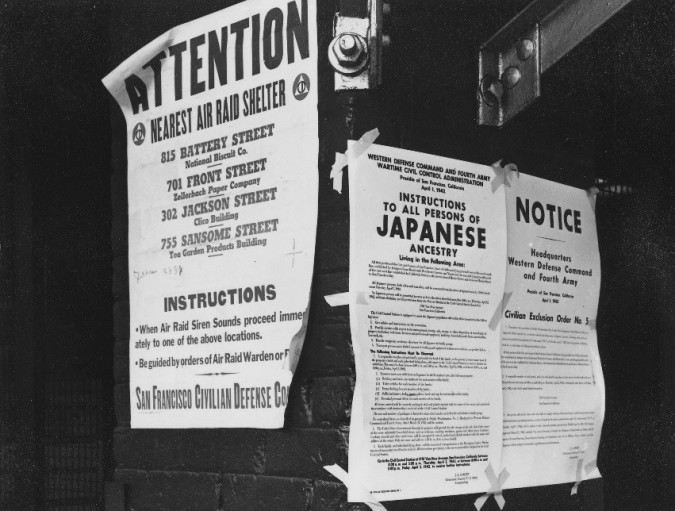Ten Camps, One Executive Order
Remembering Japanese American Internment and the Road to Reparations

On February 19, 1942, Franklin D. Roosevelt issued Executive Order 9066, which imprisoned over 100,000 Japanese Americans—about two-thirds of whom were U.S. citizens—in one of 10 internment camps across the country’s westernmost states.
Zoot Suit creator Luis Valdez’s latest, Valley of the Heart—onstage at the Mark Taper Forum October 30 – December 9, 2018—revisits this wrenching time through the story of two immigrant families: the Yamaguchis and the Montaños. If the play has inspired you to dig deeper into this chapter of our country’s history, here are some narratives and resources that have helped us better understand how Japanese American internment is remembered and commemorated today.
99% Invisible: Manzanar
Dear Earl
—The Fair Play Committee, Earl Warren, and Japanese InternmentDrunk History: Frank Emi Defies the Draft of Japanese Americans During World War II
Japanese American National Museum
President Reagan’s Remarks and Signing Ceremony for the Japanese-American Internment Compensation Bill
NPR—Code Switch: For Some Japanese Americans, Border Separations Are Déjà Vu

Growing up in 1950s California, Warren Furutani, a fourth-generation Japanese American who later became a politician, occasionally heard his parents talk about camp.
He eventually learned it wasn’t the YMCA or summer camp he had imagined. In 1969, along with 150 other Japanese Americans, Furutani traveled to the closest internment camp from Los Angeles—Manzanar. In this episode of 99% Invisible, Furutani discusses the formation of the Manzanar Committee, which continues to raise public awareness of the internment and hosts an annual pilgrimage to Manzanar every spring.

Earl Warren was the 30th Governor of California and an American jurist who played a pivotal role in the relocation of Japanese Americans without charges or due process. In response, a prominent figure in Oakland, Warren’s friend Alfred J. Lundberg, led the Fair Play Committee—a group that lobbied for the immediate release and return of people from internment camps. In 1953, Warren was appointed Chief Justice of the U.S. Supreme Court and continued to defend his stance on wartime internment. It was not until after his death in 1974, in The Memoirs of Earl Warren, that he offered the closest thing to a public apology: It was wrong to react so impulsively without positive evidence of disloyalty, even though we felt we had a good motive in the security of our state.
Frank Emi was a Japanese American civil rights activist who was relocated to the Heart Mountain camp in Wyoming in 1942. When the Army started drafting Japanese American men to go off to fight in World War II, Emi formed the Heart Mountain Fair Play Committee to protest the draft. Fresh Off the Boat’s Randall Park tipsily narrates this Drunk History episode, while Aaron Takahashi plays Frank Emi. According to Park, No 'shikata ga nai'
—a rejection of the Japanese saying It cannot be helped
—became the mantra of the Heart Mountain Fair Play Committee.

The Japanese American National Museum (JANM) in Los Angeles is committed to preserving and sharing experiences of Japanese Americans. Their ongoing exhibit Common Ground: The Heart of Community
chronicles over a century of Japanese American history and displays an original barrack from Heart Mountain. If you can’t make it to JANM, check out their interactive website. Enemy Mail: An American Story of Wartime Separation
showcases a series of letters sent by businessman Gihachi Yamashita to his family after being separated during internment, as well as the petitions his daughters sent to the government for their father’s release.
On August 10, 1988—almost 50 years after Pearl Harbor—President Ronald Reagan signed the Civil Liberties Act of 1988, granting reparations to Japanese Americans interned during World War II. The act gave each surviving U.S. citizen a redress check of $20,000, and a total of 82,219 people received this compensation. Yet no payment can make up for those lost years,
Reagan said in this speech at Washington, D.C. So, what is most important in this bill has less to do with property than with honor. For here we admit a wrong; here we reaffirm our commitment as a nation to equal justice under the law.

The events happening at the southern U.S. border today feel all too familiar for many Japanese Americans who lived through World War II. Tony Osumi was a child when he witnessed the FBI pull fathers away from their families, without notice or mention of how long they would be gone, immediately after Pearl Harbor. Executive Order 9066 quickly followed, and all Japanese American families living in the western states were subsequently interned. Today, border separations remain something that's deeply personal for many of us
Japanese Americans, Osumi said. The incarceration experience where families were very similarly torn apart as they were put in the camps and the lasting scars that many people carried from that, has led to deep emotional and visceral reactions
to what’s currently happening in the news.
